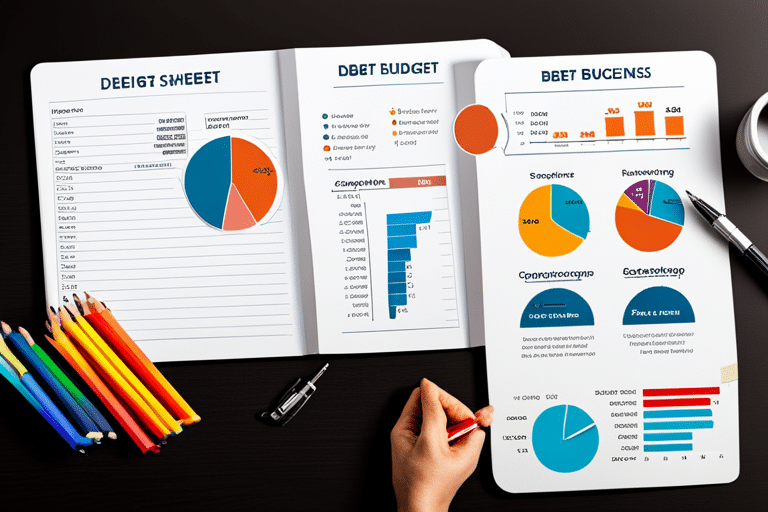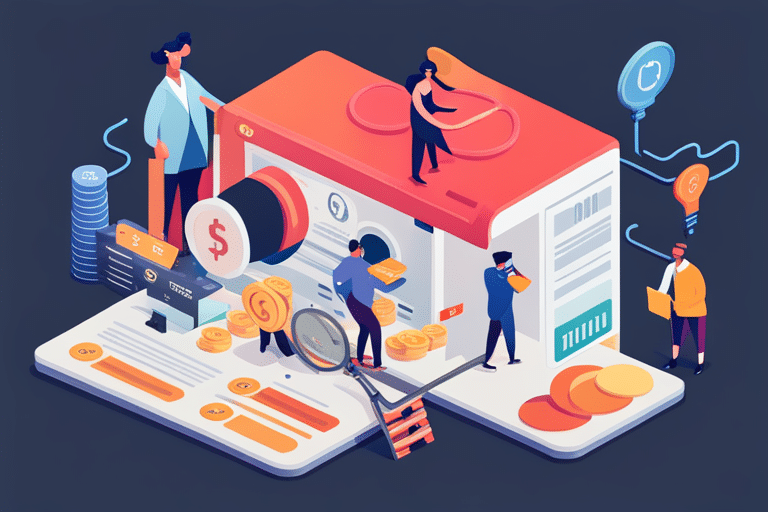Hey you, tired of drowning in debt? It’s time to take control and set realistic goals for debt reduction.
This article is your ultimate guide, packed with tips and tricks to help you achieve financial freedom. We’ll show you how to:
– Assess your current debt situation
– Understand the importance of goal setting
– Identify your financial priorities
With a little determination and some savvy budgeting skills, you can say goodbye to the burden of debt and hello to a brighter future.
Let’s get started!
Key Takeaways
- Gather all financial documents to assess current debt
- Evaluate spending habits to identify areas for cutbacks or adjustments
- Break down bigger goals into smaller, more manageable milestones
- Celebrate small victories along the way
Assessing Your Current Debt Situation

You should start by gathering all your financial documents to assess how much debt you currently have. Picture this: you’re on a treasure hunt, but instead of searching for gold, you’re looking for those pesky credit card bills and loan statements. Armed with a pen and a calculator, you dive into the sea of paperwork, ready to conquer your debt.
As you evaluate your financial situation, it’s important to take a step back and really understand what you’re up against. Assessing your debt management skills is like solving a puzzle – each piece represents a different aspect of your finances. Take note of every outstanding balance, interest rate, and monthly payment. This is where the real fun begins!
Once you’ve gathered all the information, it’s time to play detective. Look closely at your spending habits and identify any areas where you can cut back or make adjustments. Maybe that daily latte habit isn’t worth sacrificing your financial freedom? Or perhaps dining out every weekend could be replaced with home-cooked meals?
Remember, assessing your current debt situation is all about gaining clarity and understanding where you stand financially. By evaluating every aspect of your financial life, from debts to spending habits, you’ll be better equipped to create a plan that fits your needs and goals.
Understanding the Importance of Goal Setting

So, you’ve decided to embark on a journey of self-improvement! Well, buckle up because we’re going to dive into the exciting world of goal setting.
Trust me, setting goals isn’t just about making lists and checking boxes; it’s about unlocking your full potential, setting achievable targets, and staying motivated throughout the process.
Get ready to be amazed by the benefits that await you on this goal-setting adventure!
Benefits of Goal Setting
One of the benefits of goal setting is that it helps you stay motivated throughout your debt reduction journey. When you set clear goals, it gives you something to work towards and keeps you focused on your financial goals. Here are three ways goal setting can help you stay motivated:
-
Visualize Your Success: Set specific targets for how much debt you want to pay off each month or year. Imagine how amazing it will feel when you reach those milestones and visualize yourself being debt-free.
-
Celebrate Small Victories: Break down your bigger goals into smaller, more manageable ones. Each time you achieve a small milestone, reward yourself with something that makes you happy. It could be a small treat or a fun activity that doesn’t break the bank.
-
Track Your Progress: Keep track of your progress by using a visual tool like a debt reduction chart or an app. Seeing how far you’ve come can provide a sense of accomplishment and motivate you to keep going.
Setting Achievable Targets
To set achievable targets, start by breaking down your larger objectives into smaller, more manageable milestones. Think of it as climbing a mountain – you wouldn’t try to reach the peak in one giant leap, would you? No way! You’d take it step by step, enjoying the journey along the way.
When it comes to setting realistic expectations for achieving targets, remember that Rome wasn’t built in a day. It’s important to be patient with yourself and understand that progress takes time. Don’t beat yourself up if you don’t hit every milestone right away. Instead, focus on the small victories and celebrate them.
Staying Motivated Throughout
You can stay motivated throughout your financial journey by focusing on the progress you’ve made and finding inspiration in each step forward. Remember, staying focused is key to achieving your goals.
Here are some fun ways to keep yourself motivated:
-
Celebrate small victories: Treat yourself to a little reward every time you hit a milestone. It could be something as simple as treating yourself to a fancy coffee or buying that book you’ve been eyeing.
-
Surround yourself with positivity: Surround yourself with people who support and encourage your financial goals. They will inspire you to keep going when the going gets tough.
-
Visualize your success: Create a vision board or use an app that allows you to visualize your financial dreams. Seeing those images every day will remind you of why you’re working so hard.
By implementing these strategies, you’ll find it easier to stay focused and inspired on your journey towards financial success.
Now, let’s dive into identifying your financial priorities…
Identifying Your Financial Priorities

Identifying your financial priorities is key when setting realistic goals for debt reduction. It’s like playing a game of chess – you need to strategize and plan your moves carefully. So, let’s dive right in and discover how you can prioritize your financial goals and identify your spending habits.
To help you visualize the process, here’s a handy table that will guide you through the steps:
| Financial Priorities | Importance Level | Current Spending Habits |
|---|---|---|
| Paying off credit card debt | High | Regularly using credit cards for unnecessary purchases |
| Building an emergency fund | Medium | Spending impulsively without saving any money |
| Saving for retirement | Low | Not contributing to a retirement account |
| Buying a house | Medium | Renting an expensive apartment |
| Funding education | High | Neglecting student loan payments |
Now that you have identified your financial priorities and assessed your current spending habits, it’s time to make some changes. Focus on reducing unnecessary expenses, paying off debts with higher interest rates first, and start saving towards those important goals. Remember, small steps can lead to big results!
Determining a Realistic Timeline

After assessing your financial priorities and spending habits, it’s important to determine a realistic timeline for achieving your goals. Setting a timeline will help you stay motivated and focused on paying off your debt. So, grab your calculator and let’s get started!
Here are some factors to consider when determining a realistic timeline:
-
Debt amount: Take a look at the total amount of debt you owe. It can be overwhelming, but don’t panic! Breaking it down into manageable chunks will make it easier to tackle.
-
Income: Your income plays a big role in how quickly you can pay off your debt. Consider how much money you have available each month to put towards paying down your balances.
-
Interest rates: High-interest rates can slow down your progress. Prioritize paying off debts with the highest interest rates first to save yourself some money in the long run.
Tracking your progress is key! Celebrate small victories along the way and adjust your goals as needed. Remember, this journey might take time, but with determination and perseverance, you’ll reach that debt-free destination sooner than you think!
Now go forth and conquer that debt mountain! You’ve got this!
Creating a Budget That Supports Debt Reduction

To create a budget that supports reducing your debt, take a close look at your monthly expenses and identify areas where you can cut back. Budgeting strategies are like puzzle pieces – they help you fit all the financial pieces together to form a picture of debt-free living. One useful strategy is tracking expenses, which allows you to see exactly where your money is going and identify any unnecessary spending habits.
Let’s imagine your budget as a garden. In one corner, we have the essential expenses: rent/mortgage, utilities, and groceries. These are like the sturdy oak trees that provide necessary shade and sustenance. In another corner, we have the discretionary expenses: dining out, entertainment, and shopping sprees. These are like the beautiful flowers that bring joy but can also drain your resources if not kept in check.
By analyzing each expense category in detail, you can determine how much room there is for trimming or eliminating certain purchases. Use the table below to track your monthly expenses:
| Category | Monthly Expense | Potential Savings |
|---|---|---|
| Housing | $1500 | N/A |
| Utilities | $200 | $20 |
| Groceries | $400 | $50 |
| Dining Out | $300 | $100 |
As you identify areas where you can cut back on spending, remember that every dollar saved brings you closer to your goal of reducing debt.
Now that we’ve created a budget that supports debt reduction by cutting back on unnecessary expenses, let’s explore different debt repayment strategies…
Exploring Different Debt Repayment Strategies

So, you’ve decided to tackle your debt head-on. But now, you’re faced with a big question: Snowball or Avalanche? It’s like choosing between hot cocoa with marshmallows or a thrilling downhill ride on a snow-covered mountain.
Both strategies have their merits, but which one will work best for you? Let’s dive into the differences and find out which strategy will help you conquer your debt in the most satisfying way possible.
Snowball Vs Avalanche
When it comes to debt reduction, deciding between the snowball and avalanche methods can be tricky. But fear not, my debt-slaying friend! Let’s break it down for you.
The Snowball Method: Picture this – you start by tackling your smallest debt first, while making minimum payments on all others. Once that small debt is gone, you take the money you were putting towards it and add it to the next smallest debt. It’s like a rolling snowball of momentum!
The Avalanche Method: Now imagine an icy avalanche descending upon your debts. With this method, you focus on paying off your highest interest rate debt first. By targeting the big financial boulders first, you’ll save more money in the long run.
So which method should you choose? Well, both have their merits. If motivation is what gets your wheels turning, go for the Snowball Method. If saving on interest charges makes your heart skip a beat, then embrace the Avalanche Method.
Which Strategy Works?
Both the snowball and avalanche methods have their advantages, so it ultimately depends on your personal preferences and financial goals. Differentiating these strategies can be fun and exciting, like choosing between two flavors of ice cream.
Evaluating their effectiveness is like comparing two superheroes in a battle for debt reduction supremacy. The snowball method, with its small victories and motivational boost, may appeal to those who thrive on instant gratification.
On the other hand, the avalanche method’s focus on interest rates and saving money in the long run might suit those with a more strategic mindset.
Whichever strategy you choose, remember that mastery comes from understanding yourself and your financial situation. So go forth, evaluate your options, and embark on your debt-reducing adventure!
Maximizing Your Income and Minimizing Expenses

To maximize your income and minimize expenses, you should consider taking on a side job or cutting back on unnecessary spending. It may sound daunting, but with a little creativity and discipline, you can make it happen. Here are some tips to get you started:
-
Get crafty: Do you have a hidden talent that could bring in some extra cash? Whether it’s painting, baking, or knitting, turn your hobby into a side business. Sell your creations online or at local markets.
-
Embrace the gig economy: Sign up for platforms like Uber or TaskRabbit to earn money on your own terms. You can drive people around town or complete odd jobs in your spare time.
-
Trim the fat: Take a good look at your expenses and identify areas where you can cut back. Do you really need that daily latte from the fancy coffee shop? Brewing your own coffee at home can save you big bucks in the long run.
Building an Emergency Fund

Building an emergency fund is essential for financial security and can provide a safety net in times of unexpected expenses or income loss.
Picture this: you’re strolling down the street, feeling on top of the world, when suddenly your phone slips from your hand and crashes onto the concrete below. Shattered screen, shattered dreams. But fear not! With a well-built emergency fund, you can handle these surprise expenses without breaking a sweat.
So how do you go about building savings for those pesky emergencies? It’s simple really. Start by setting aside a small portion of your income each month – think of it as paying yourself first. Treat it like a game: challenge yourself to save more each time until you reach your goal. You’ll be surprised at how quickly those little contributions add up.
Now let’s talk about those emergency expenses that seem to come out of nowhere – we’re talking car repairs, medical bills, or even sudden job loss. These things happen to everyone at some point in life, but with an emergency fund in place, you won’t have to panic. You’ll have peace of mind knowing that you’ve got money set aside specifically for moments like these.
Seeking Professional Advice or Assistance

So, you’ve been working hard to build that emergency fund and tackle your debt.
But now you’re wondering what’s next?
Well, my friend, it might be time to seek some professional advice or assistance.
Don’t worry, though! Expert guidance for success is just a phone call away.
And those financial professionals can work their magic and help you navigate the tricky waters of personal finance with ease.
Expert Guidance for Success
Looking for expert guidance to succeed in your debt reduction goals? Well, look no further! Here are some success tips from the pros that will help you stay on track and achieve financial freedom:
-
Create a realistic budget: Start by listing all your income and expenses. Cut back on unnecessary spending and allocate more towards paying off your debts.
-
Prioritize your debts: Make a list of all your debts, including their interest rates. Focus on paying off high-interest debts first to save money in the long run.
-
Seek professional advice: Consult with a financial advisor or credit counselor who can provide expert guidance tailored to your specific situation.
By following these expert tips, you’ll be well-equipped to tackle your debt head-on and pave the way towards a brighter financial future.
Financial Professionals Can Help
Financial professionals can offer valuable assistance in achieving your financial goals and guiding you towards a more secure future. Imagine having a personal finance wizard by your side, waving their magic wand and helping you navigate the complex world of debt reduction strategies.
These financial advisors are like the superheroes of money management, swooping in to save the day and rescue you from the clutches of overwhelming debt.
With their expertise, they can analyze your financial situation, create a customized plan tailored to your specific needs, and help you develop a roadmap for paying off those pesky debts. They’ll provide insights on how to prioritize payments, negotiate with creditors, and even suggest ways to increase your income.
Staying Motivated and Accountable

To stay motivated and accountable while setting realistic goals for debt reduction, you should create a visual reminder of your progress. It’s easy to lose sight of your goals when you’re buried under a pile of bills and statements. That’s why having something tangible to look at can make all the difference.
Here are three fun ways to track your progress:
-
Debt Thermometer: Draw a giant thermometer on a poster board and color it in as you pay off your debt. With each payment, watch the red line rise closer to the top, inching towards your goal. It’s like watching your debt melt away!
-
Jar of Marbles: Get yourself a jar and some colorful marbles. Each marble represents a certain amount of money or debt paid off. As you make payments, drop those marbles into the jar and watch it fill up with progress.
-
Paper Chain Countdown: Cut strips of colored paper and create a chain that represents each month or week until you reach your goal date. Every time you make progress, remove one link from the chain until it’s gone completely.
Celebrating Small Victories Along the Way

Hey there, champion! So you’ve been on this journey to conquer your debt, and let me tell you, every step counts!
In this discussion, we’re going to explore the importance of acknowledging progress milestones. But wait, it gets even better – we’ll also dive into finding joy in each step towards financial freedom and how those small wins can keep you motivated throughout the entire process.
Trust me, celebrating these victories is like throwing a party for yourself and your bank account!
Acknowledging Progress Milestones
It’s important to celebrate the small wins along your debt reduction journey. Acknowledging milestones and celebrating achievements can help keep you motivated and focused on your goal. So, let’s take a moment to appreciate how far you’ve come!
Here are some ways to acknowledge your progress milestones:
-
Treat yourself: Reward yourself with something small but meaningful when you reach a milestone, like treating yourself to a favorite dessert or buying that book you’ve been eyeing.
-
Share your success: Tell someone about your achievement, whether it’s a friend or family member who understands the challenges of debt reduction or an online community where you can find support and encouragement.
-
Reflect on the journey: Take time to reflect on how much progress you’ve made since starting your debt reduction journey. Write down what you’re proud of and remind yourself of all the hard work you’ve put in.
By acknowledging these milestones and celebrating your achievements, you’ll find renewed motivation to continue moving forward towards financial freedom.
Now, let’s explore how finding joy in progress can further enhance your debt reduction efforts.
Finding Joy in Progress
Finding joy in the progress you’ve made can be a powerful motivator to keep pushing towards your financial goals.
Picture this: You’re climbing a mountain of debt, and with each step, you feel lighter, happier. As you reach higher, you start to see glimpses of the summit – a life free from the burden of owing money.
The feeling of accomplishment washes over you like warm sunshine on a chilly day. You realize that finding happiness and fulfillment isn’t just about reaching the top; it’s about cherishing every milestone along the way.
Take a moment to celebrate each small victory – paying off a credit card, reducing your loan balance – because these moments are what make your journey worthwhile. Embrace the joy in progress and let it fuel your determination to conquer any financial challenge that comes your way.
Keep pushing forward, knowing that happiness awaits at the end of this debt-free road.
Motivating Through Small Wins
Celebrating each small victory along your financial journey can be a powerful motivator to keep pushing forward. As you work towards your debt reduction goals, it’s important to find motivating techniques that keep you inspired and excited about your progress.
One effective strategy is implementing a reward system that recognizes and celebrates the milestones you achieve. Here are three fun ways to incorporate rewards into your financial journey:
- Treat yourself to a small indulgence, like a fancy coffee or a new book, every time you pay off a certain amount of debt.
- Create a visual tracker where you can mark off each milestone reached, and treat yourself to a special outing once you hit certain checkpoints.
- Set up regular ‘money dates’ with yourself to review your progress, and reward yourself with something enjoyable if you’re on track.
By celebrating these small wins and incorporating rewards into your journey, you’ll stay motivated and focused on reaching your ultimate goal of becoming debt-free.
Now let’s explore the importance of reevaluating and adjusting your goals as needed…
Reevaluating and Adjusting Your Goals as Needed

When reevaluating and adjusting your goals as needed, make sure to take into account any changes in your financial situation. Life has a funny way of throwing curveballs at us, doesn’t it? One moment you’re on track, confidently marching towards your debt reduction goals, and the next moment BAM! You find yourself facing unexpected expenses or a change in income.
But fear not, my friend! This is where the art of reevaluating goals and adjusting targets comes into play.
Think of it as a dance – a graceful twirl to the left or a quick step to the right. Just like in dancing, flexibility is key when it comes to achieving financial mastery. So, grab your imaginary partner (let’s call them Financial Freedom) and let’s embark on this waltz together.
First things first: evaluate your new financial situation objectively. Has there been an increase or decrease in income? Are there any additional expenses that have cropped up? Take stock of these changes before proceeding further.
Now that you’ve gathered all the necessary information, it’s time to reassess those goals. Perhaps you need to adjust the timeline for paying off your debts or set new milestones along the way. Remember, this isn’t about giving up; it’s about adapting and finding alternative routes towards success.
Avoiding Common Pitfalls and Temptations

Avoiding common pitfalls and temptations requires staying disciplined and having a clear understanding of your financial priorities. When it comes to managing debt, it’s easy to get caught up in impulsive spending and fall into the trap of overspending. But fear not! Here are some strategies that will help you stay on track and avoid succumbing to those tempting spending habits:
-
Create a budget: Take the time to assess your income, expenses, and debt obligations. By creating a budget, you’ll have a better understanding of where your money is going and can allocate funds accordingly.
-
Set realistic goals: Break down your debt into manageable chunks and set achievable goals for paying it off. Celebrate milestones along the way to keep yourself motivated.
-
Find alternative ways to reward yourself: Instead of indulging in impulsive purchases, find other ways to treat yourself when you reach financial milestones. Maybe that means treating yourself to a spa day or taking a weekend getaway with friends.
Remember, avoiding impulsive spending takes practice and determination. Stay focused on your long-term financial goals, prioritize your debts wisely, and don’t be afraid to seek support from friends or family when needed.
With these strategies in place, you’ll be well on your way to mastering the art of managing debt temptations!
Maintaining a Long-Term Debt-Free Mindset

To maintain a long-term debt-free mindset, it’s important to consistently prioritize your financial well-being and make informed decisions about your spending habits. It’s easy to get caught up in the excitement of buying new things or going on extravagant vacations, but remember that true happiness comes from financial stability and freedom.
One way to stay on track is by setting realistic goals for yourself. Think about what you want to achieve in the long term and break it down into smaller, manageable steps. This will make the journey feel less overwhelming and more attainable.
Another helpful strategy is creating a budget that aligns with your goals. By tracking your income and expenses, you can see where your money is going and identify areas where you can cut back. It’s like being a detective, uncovering hidden ways to save!
Lastly, surround yourself with like-minded individuals who understand your desire for long-term success. This could be joining a support group or finding an accountability partner who shares similar financial goals. Together, you can cheer each other on as you navigate the path towards financial freedom.
Frequently Asked Questions
How Can I Track My Progress in Reducing My Debt?
You can track your progress in reducing debt by using budgeting tools. They help you monitor income, expenses, and savings. With these tools, you’ll have a clear picture of your financial journey.
What Are Some Common Mistakes People Make When Setting Debt Reduction Goals?
Avoid common mistakes when setting debt reduction goals. Don’t fall into the trap of aiming for the impossible or underestimating your progress. Instead, use effective strategies to set realistic goals and celebrate every milestone along the way.
Is It Necessary to Seek Professional Advice or Assistance When Trying to Reduce Debt?
Seeking professional advice or assistance when reducing debt can be beneficial. Professionals have the knowledge and experience to guide you through the process, helping you set realistic goals and providing strategies for success.
How Can I Stay Motivated and Accountable Throughout the Debt Reduction Process?
Staying motivated and accountable throughout the debt reduction process can be challenging. But fear not! By setting small milestones, rewarding yourself, and finding a support system, you’ll conquer your debts in no time.
What Should I Do if I Encounter Unexpected Expenses While Trying to Reduce My Debt?
If you encounter unexpected expenses while reducing debt, don’t panic! Take a deep breath and assess the situation. Look for ways to manage financial emergencies, like cutting back on non-essentials or finding creative ways to increase your income. You got this!
Conclusion
Congratulations! You’ve reached the end of this journey towards debt reduction. By setting realistic goals, creating a budget, and staying focused, you’re well on your way to achieving financial freedom.
Did you know that according to a recent study, 80% of people who set specific goals are more likely to achieve them? So keep pushing forward and celebrate each small victory along the way.
Remember, it’s all about maintaining a long-term debt-free mindset. Stay motivated and watch as your debt disappears into thin air!

